Articles & Videos
How bar models can help students interpret word problems
Categories
Subscribe to our newsletters
Receive teaching resources and tips, exclusive special offers, useful product information and more!
How bar models can help students interpret word problems
Maths Trek 19/5/25
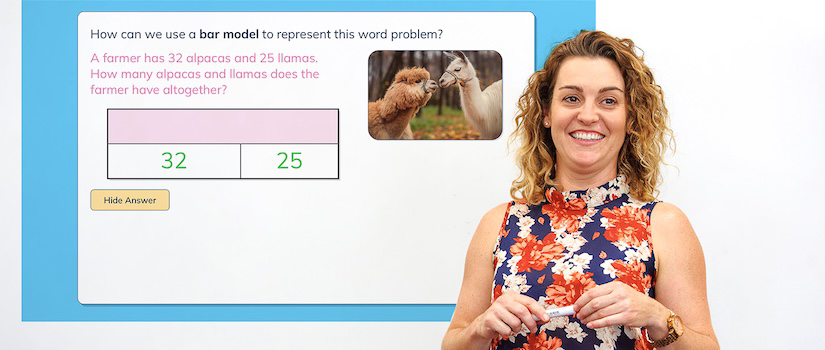
Interpreting mathematical word problems is no easy task! Studies show a number of factors contribute to students finding word problems difficult, from the number of steps to the combination of skills involved including reading comprehension, reasoning and problem-solving.1 2 To add to that, students need to recall conceptual and procedural information, make calculations and interpret mathematical language – it’s no wonder word problems are so challenging.1 3 4 5
But bar models can help!
What are bar models?
Bar models are visual thinking tools known for their use in the Singapore maths curriculum and linked to the Concrete Pictorial Abstract (CPA) approach to teaching mathematics.6 The purpose of bar modelling is to assist students in understanding a word problem by helping them to recognise part-part-whole relationships and identify the steps required to solve a word problem.5 6 7 For this reason, bar modelling supports students to complete the first two principles of Polya’s problem-solving process – understanding the problem and devising a plan – before allowing students to select written or mental computational methods to solve the problem and reflect on their answer.8 9
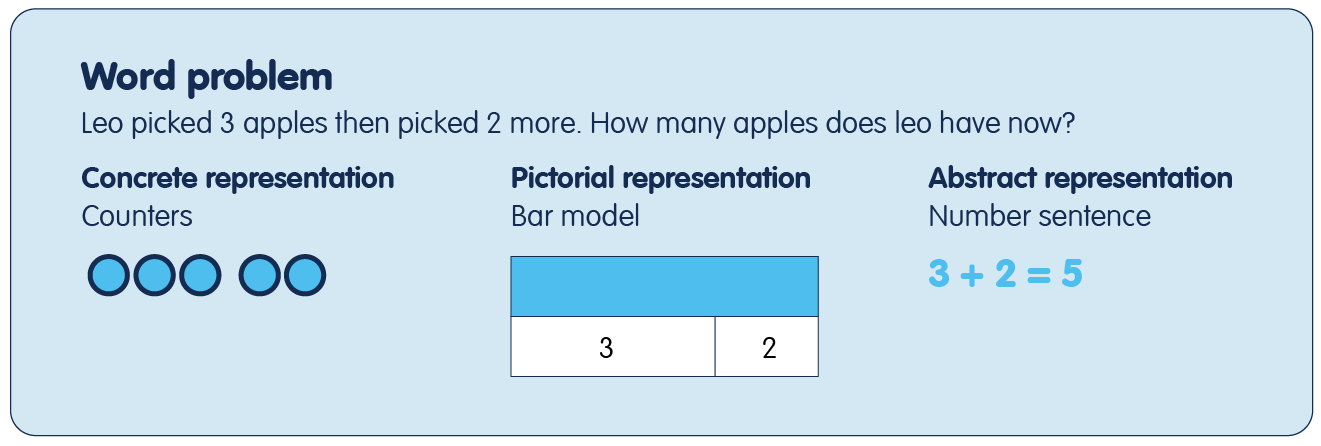
As visual representations of mathematical contexts, bar models help students to bridge the gap between reading and comprehending a word problem and working with an abstract number sentence to solve the problem.
A snapshot of bar modelling in Maths Trek
Let’s see how bar modelling can be used in a variety of contexts in maths lessons.
As a dedicated explicit teaching lesson
Students are first taught how to use bar models in Year 2, with further explicit teaching of bar models occurring in Years 3 and 4. In these dedicated bar modelling lessons, students explicitly learn to use a bar model as a visual aid to unpack a simple word problem and fill in a blank bar model. The lesson guide prompts the teacher to use questioning to unpack the word problem and point out the features of a bar model.
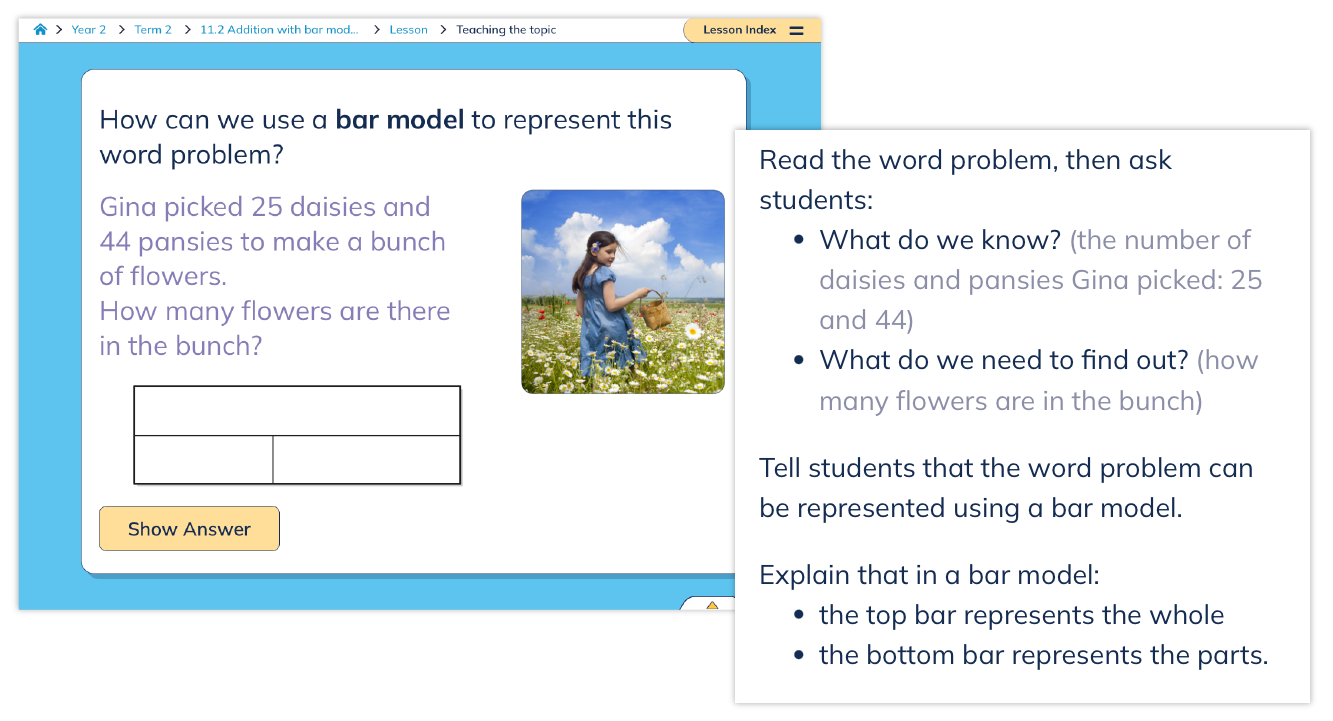
The teacher then leads the class to identify and place important information in the bar model, and decipher the operation required to solve the problem. The use of targeted questioning aims to consolidate part-part-whole relationships in the word problem and justify decisions regarding the bar model.
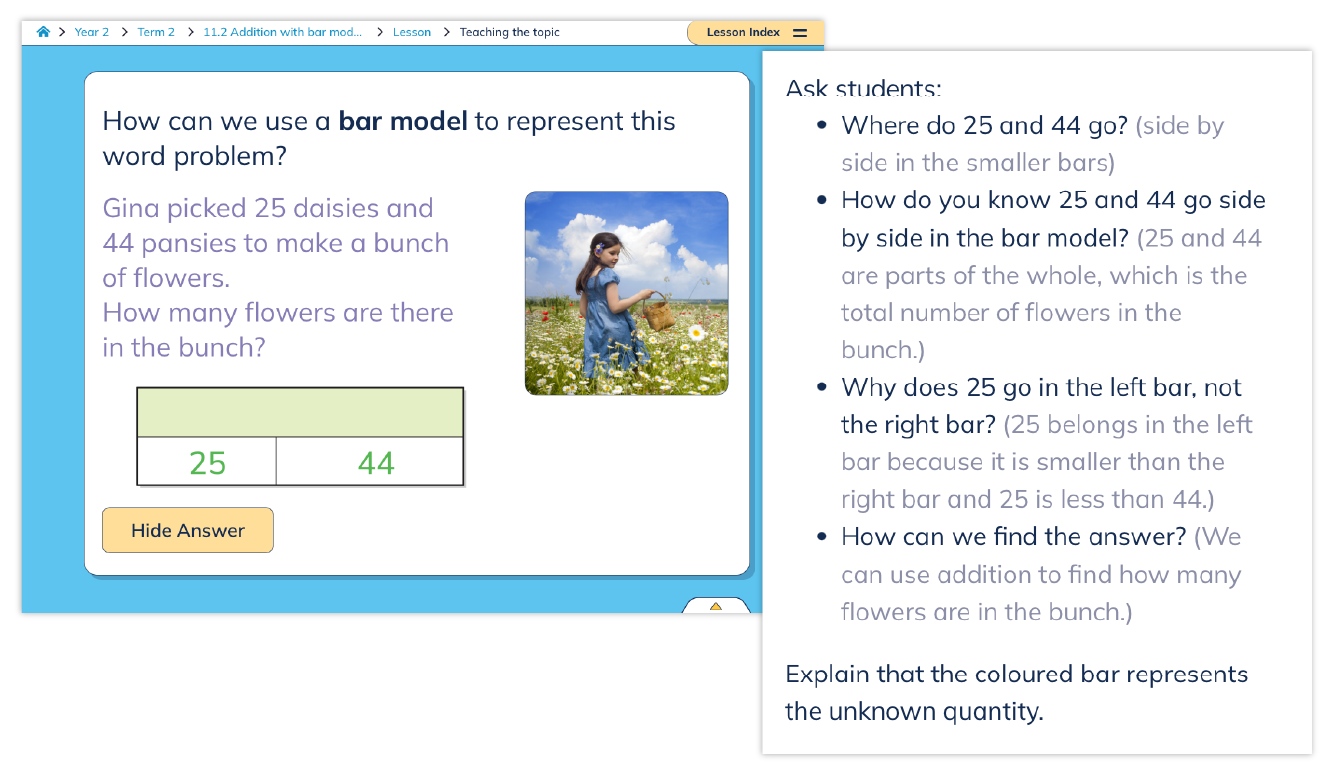
By providing a blank bar model to fill in, the cognitive load of the problem is reduced but still challenges students to justify where important information should be placed.8
From here, the lesson shifts to an abstract representation of the problem (a number sentence) and a familiar strategy (split strategy for two-digit addition) is used to solve the problem. By keeping the addition simple and scaffolding the steps in the process, potential barriers to learning are reduced allowing the focus of the lesson to remain on the bar model.
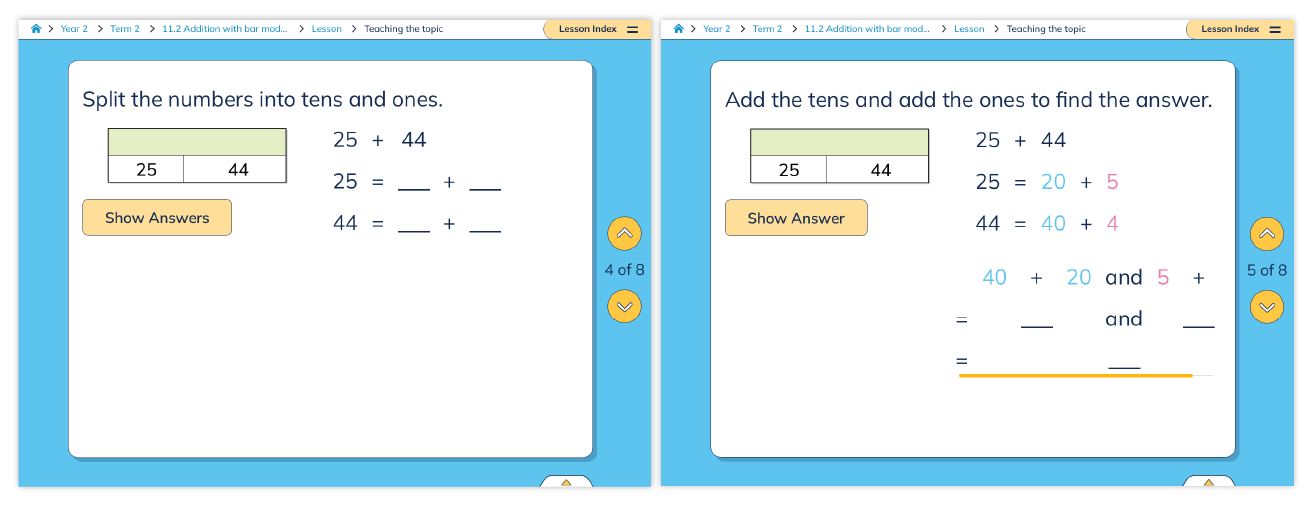
Embedded into other topic lessons
While there are a handful of explicit bar model topic lessons, how Maths Trek embeds the use of bar models in other related topics is just as impactful. This incidental embedding gives students a considered and layered approach to using bar models. Embedding bar models into lessons occurs right through to Year 6. For example, this Year 3 lesson incorporates bar modelling in the warm up activity and acts as a springboard to learn a new addition strategy (two-digit addition with regrouping). Like the explicit bar modelling topics, the lesson guide provides helpful questions and notes to support learning.
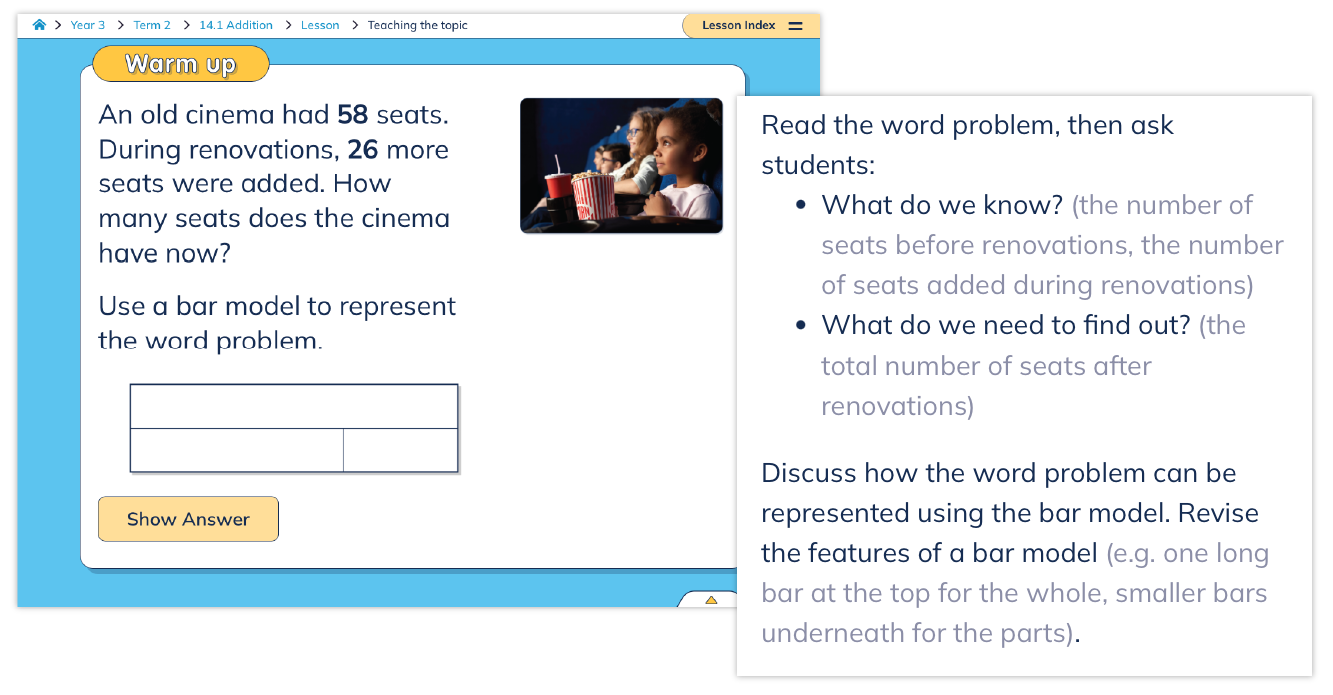
Similar to the explicit bar modelling topics, the lesson then shifts to an abstract representation of the problem (a number sentence) and demonstrates how to use the chosen strategy (a place value algorithm) to solve the problem.

This style of lesson promotes the familiarity of word problems, problem-solving and the use of bar modelling, under the careful guidance of the classroom teacher. It provides isolated focus for word problems and bar modelling in everyday lessons, adds value and purpose to the specific topic content being covered and guides students towards using bar models independently.5 7 In addition, the use of concrete materials can provide additional support to students as they bridge the gap between concrete, pictorial and abstract representations of the problem.10
Even in problem-solving lessons
Bar modelling is also incorporated into the Guessing and checking problem-solving strategy activities from Years 3 to 6. Bar models are ideal for this particular strategy as they can help students visualise quantities and make educated guesses to solve a problem involving a part-part-whole relationship.
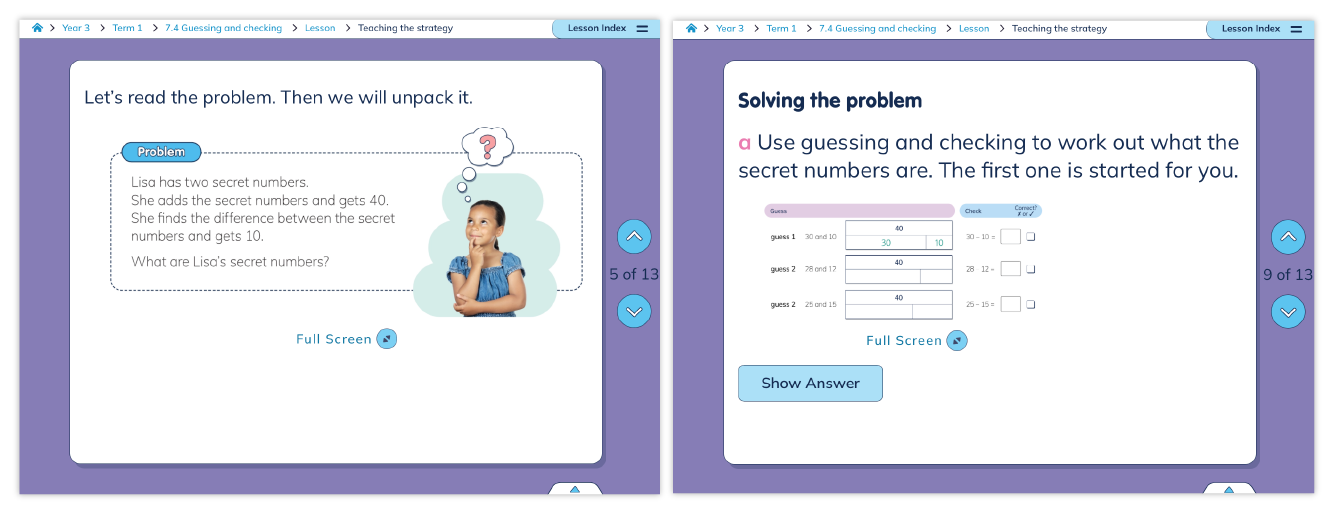
Teaching bar models is just one of the many valuable features of the Maths Trek program. Experience it for yourself with a free trial, or dive deeper by booking a professional learning workshop for your school to explore the program’s content, tools and features in detail.
References
Powell, SR, Urrutia, VY, Berry, KA & Barnes, MA 2022, ‘The word-problem solving and explanations of students experiencing mathematics difficulty: a comparison based on dual-language status’, Learning Disability Quarterly, vol. 45, no. 1, pp. 6-18, https://doi.org/10.1177/0731948720922198
Genet, S 2024, ‘Pre-service teachers and ChatGPT in multi strategy problem-solving: Implications for mathematics teaching in primary schools’, International Electronic Journal of Mathematics Education, vol. 19, no. 1, pp. 1-12, https://doi.org/10.29333/iejme/14141
Lee, NH, Yeo, DJS & Hong, SE 2014, ‘A metacognitive-based instruction for primary four students to approach non-routine mathematical word problems’, ZDM Mathematics Education, vol. 46, no. 3, pp. 465-480, doi: 10.1007/s11858-014-0599-6
Verschaffel, L, Schukajlow, S, Star, J & Van Dooren, W 2020, ‘Word problems in mathematics education: a survey’, ZDM Mathematics Education, vol. 52, no.1, pp. 1-16, https://doi.org/10.1007/s11858-020-01130-4
Osman, S, Yang, CNAC, Abu, MS, Ismail, N, Jambari, H & Kumar, JA 2018, ‘Enhancing students’ mathematical problem-solving skills through bar model visualisation technique’, International Electronic Journal of Mathematics Education, vol. 13, no. 3, pp. 273-279, https://doi.org/10.12973/iejme/3919
Hough, S, Gough, S & Solomon, Y 2019, ‘Connecting the everyday with the formal: the role of bar models in developing low attainers’ mathematical understanding’, Congress of the European Society for Research in Mathematics Education, CERME 11, Utrecht, The Netherlands, 6-10 February 2019, pp. 1-8.
Shah, M 2022, ‘Determining the effect of bar model technique on students’ mathematical word problem solving skills’, Journal of Contemporary Teacher Education, vol. 6, no. 1, pp.145-156
Schwarz, V 2017, ‘Understanding problems: Using bar models with common core taxonomies’, Yale National Initiative to strengthen teaching in public schools, vol. V, pp. 1-32, https://teachers.yale.edu/pdfs/curriculum_pdfs/17.05.03.pdf
Polya, G 2004, How to solve it: a new aspect of mathematical method, Expanded Princeton Science Library Edition, Princeton University Press, Princeton and Oxford.
Hofer, C 2015, ‘The introduction of the Singapore bar model in Year 1 problem solving: a personal reflection’, The STeP Journal: Student Teacher Perspectives, vol. 2, no. 2, pp. 107-117, https://ojs.cumbria.ac.uk/index.php/step/article/view/243